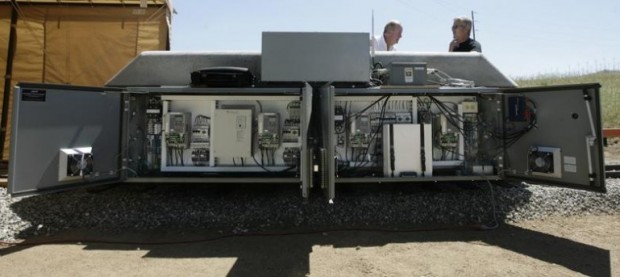One of the problems with energy generated from renewable energy sources is that the energy provided by them can be at times intermittent due to factors such as weather. For this reason it is important to have a means of energy storage. The most widespread way of accomplishing this is through the use of batteries but batteries suited for this type of energy storage can be quite expensive and only have a lifespan of around 5 years. For this reason there are several projects aimed at developing a better alternative. One of the most promising I have seen is a Regulation Energy Management (REM) created by California-based ARES (Advanced Rail Energy Storage).
The system can provide grid scale energy storage using electric locomotives pushed to the top of a slope. Its operation is actually quite straightforward. When the supply of a particular renewable energy resource is low or electricity demand rises, the heavy locomotives which make up the system are released back down the slope and electricity is generated through regenerative braking. An installation of the REM will consist of multiple vehicles on a track which can be moved independently of each other and positioned in the middle of the slope all in a queue. In order to maintain a constant energy supply, as soon as one vehicle exits the queue another one enters.
A conductor rail serves a dual purpose — in addition to providing power to the rail carts, it also transfers power generated from them to where it is needed. Important information is gathered via small leading wheels on the locomotives and relayed wirelessly to a control system responsible for executing the movements of the vehicles safely. In case of a power disruption the vehicles are outfitted with air brakes which would be automatically activated.
The system can respond to increases or decreases in demand within seconds and is capable of providing constant power for up to 8 hours and can do all of this with minimal environmental impact. Yes it does not burn any fuel or produce harmful emissions. The system is scalable and configurations providing from around 200MWh (Megawatt hours) up to 24GWh (Gigawatt hours) can be implemented. According to the company, the system also has a lower life-cycle cost than batteries. They also make the claim that it is capable of delivering energy more quickly than a pumped-storage solution.
An open day was recently held by ARES at their facility in Tehachapi, California. The facility consists of a test track and vehicle and was built to prove the concept for the patented Regulation Energy Management. The test vehicle weighs in at 12,500 lb (5,670 kg) while the track is 880ft (268m) in length. A full scale 50MW REM system is even already in the works to be installed in Pahrump, Nevada for the Valley Electric Association and the California Independent System Operator (CA-ISO). The track will be 5 miles in length (8km) and a single locomotive will weigh in at 300 tons (272 tonnes). The system will be consist of 32 vehicles each providing around 1.5MW of power.
ARES is shaping up to be quite promising and I certainly hope that it works out. See the video below of the REM in action.
[via Gizmag]

 Email article
Email article




